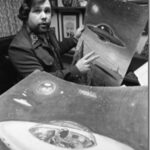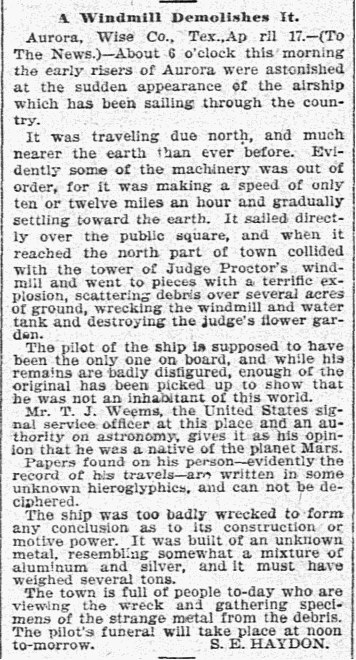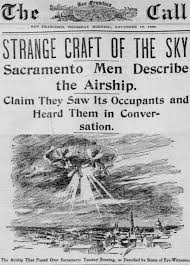by Charles Lear
 In last week’s blog, we looked at researcher/investigator Hayden Hewes and some of the cases he looked into. One of those was in Aurora, Texas, where a UFO was reported to have crashed in 1897, killing its not-of-this-world pilot. The pilot was said to have been buried in the local cemetery, and an enthusiastic Hewes attempted and failed to get an exhumation order. The case has endured in the UFO mythos despite the likelihood that the story was made up by a reporter trying to raise some publicity for a dying town. In the midst of the publicity stirred up by Hewes and other investigators, Jim and Coral Lorenzen of the Aerial Phenomena Research Organization expressed their doubts in their publication, the A.P.R.O. Bulletin.
In last week’s blog, we looked at researcher/investigator Hayden Hewes and some of the cases he looked into. One of those was in Aurora, Texas, where a UFO was reported to have crashed in 1897, killing its not-of-this-world pilot. The pilot was said to have been buried in the local cemetery, and an enthusiastic Hewes attempted and failed to get an exhumation order. The case has endured in the UFO mythos despite the likelihood that the story was made up by a reporter trying to raise some publicity for a dying town. In the midst of the publicity stirred up by Hewes and other investigators, Jim and Coral Lorenzen of the Aerial Phenomena Research Organization expressed their doubts in their publication, the A.P.R.O. Bulletin.
 The original article describing the incident headlined “A Windmill Demolished It” and written by S.E. Hayden appeared in the April 19, 1897, edition of The Dallas Morning News. According to Hayden, on April 17, at 6:00 a.m. “the early risers of Aurora were astonished at the sudden appearance of the airship which has been sailing through the country.” As most readers are probably aware, articles describing mystery airships had been appearing in newspapers throughout the U.S. at this time.
The original article describing the incident headlined “A Windmill Demolished It” and written by S.E. Hayden appeared in the April 19, 1897, edition of The Dallas Morning News. According to Hayden, on April 17, at 6:00 a.m. “the early risers of Aurora were astonished at the sudden appearance of the airship which has been sailing through the country.” As most readers are probably aware, articles describing mystery airships had been appearing in newspapers throughout the U.S. at this time.
Hayden describes the Aurora ship as possibly having had mechanical problems as it was only traveling about “ten or twelve miles per hour and gradually settling toward the Earth.” According to Hayden, after passing over the town square, it crashed into a windmill on the property of Judge Proctor in the north of town. It is described as exploding, “scattering debris over several acres of ground, wrecking the windmill and water tank and destroying the judge’s flower garden.
It is reported that there was a single pilot whose remains were badly disfigured but “enough of the original has been picked up to show that he was not an inhabitant of this world.” According to Hayden, T.J. Weems, the local U.S. signal service operator, “an authority on astronomy,” gave his opinion that the pilot was from Mars.
The strewn metal was said to have been “several tons” worth of aluminum and silver. The town is described as being full of people “viewing the wreck and gathering specimens of the strange metal from the debris.” The funeral for the pilot was reported to be scheduled for the next day.
A.P.R.O’s investigation into the case is described in the article headlined “The Aurora, Texas, Case” on the front page of the May-June 1973 issue of the A.P.R.O. Bulletin. After summing up the story, Aurora is described as having been “in pitiful straits in 1896 and 1897” due to a spotted fever epidemic, the failure of the cotton crop, and the fact that the railroad had bypassed the town. Hayden is described as being a cotton buyer “in as bad a fix as anyone else.”
The March 12, 1973 issue of Time magazine has an article on the case and 86-year-old Etta Pegues is quoted as saying that Hayden wrote the article “as a joke to bring interest to Aurora. The railroad bypassed us and the town was dying.”
 According to the Bulletin, the Aurora story lay dormant for 70 years until it was “brought up again by UFO researchers during the furor of the 1966 flap when the Condon Committee was commissioned to investigate UFO reports.” Historians in the area called the story a hoax and a scientist, Dr. Alfred E. Kraus, swept the area with a metal detector and interviewed people in the area who were alive in 1897, and he found nothing to substantiate the story. Addressing the 1973 investigation, Hewes (we presume because he is not mentioned by name) is described as “a UFO buff who has a reputation as a gadfly…”
According to the Bulletin, the Aurora story lay dormant for 70 years until it was “brought up again by UFO researchers during the furor of the 1966 flap when the Condon Committee was commissioned to investigate UFO reports.” Historians in the area called the story a hoax and a scientist, Dr. Alfred E. Kraus, swept the area with a metal detector and interviewed people in the area who were alive in 1897, and he found nothing to substantiate the story. Addressing the 1973 investigation, Hewes (we presume because he is not mentioned by name) is described as “a UFO buff who has a reputation as a gadfly…”
 There were stories about the case and the investigation in the Dallas Times Herald and the Los Angeles Herald Examiner. According to an article (page 2 of the pdf) headlined “Aurora UFO Site Probe Near Climax” in the June 3, 1973 Dallas Times Herald, investigators from the Mutual UFO Network, North Texas State University, and the Herald, had gathered metal samples in the area and were having them tested at various labs.
There were stories about the case and the investigation in the Dallas Times Herald and the Los Angeles Herald Examiner. According to an article (page 2 of the pdf) headlined “Aurora UFO Site Probe Near Climax” in the June 3, 1973 Dallas Times Herald, investigators from the Mutual UFO Network, North Texas State University, and the Herald, had gathered metal samples in the area and were having them tested at various labs.
An article (page 2 of the pdf) headlined “Texas Woman Recalls ‘UFO’ Crash in 1897” in the May 31, 1973 Los Angeles Herald Examiner quotes 91-year-old Mary Evans as saying she remembered the excitement caused by the crash but her parents wouldn’t let her go to the site.
It is reported in the Bulletin that the aluminum found at the site was “a fairly common aluminum alloy,” according to former Project Bluebook scientific consultant J. Allen Hynek who knew a scientist who had tested a sample in Canada. It’s pointed out that the local historical society hadn’t recorded the event, that the aluminum alloy showed up after Kraus’s 1967 investigation, that the only Weems in the area was a blacksmith and not a U.S. signal service operator, and that two people claiming to remember the crash, each sent investigators to separate gravesites.
The determination by A.P.R.O. is that “it seems certain that we should relegate the story of the 1897 Aurora, Texas, airship crash to the hoax bin.”
Charles Lear is the author of “The Flying saucer Investigators.”